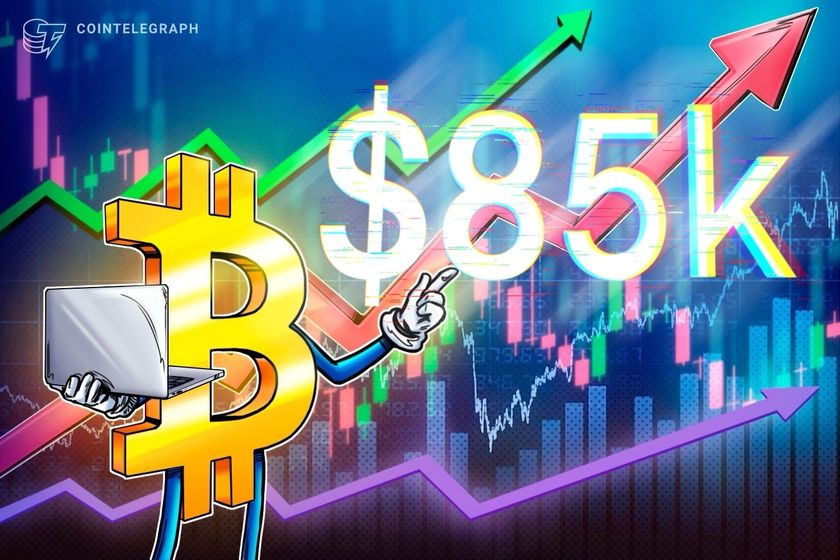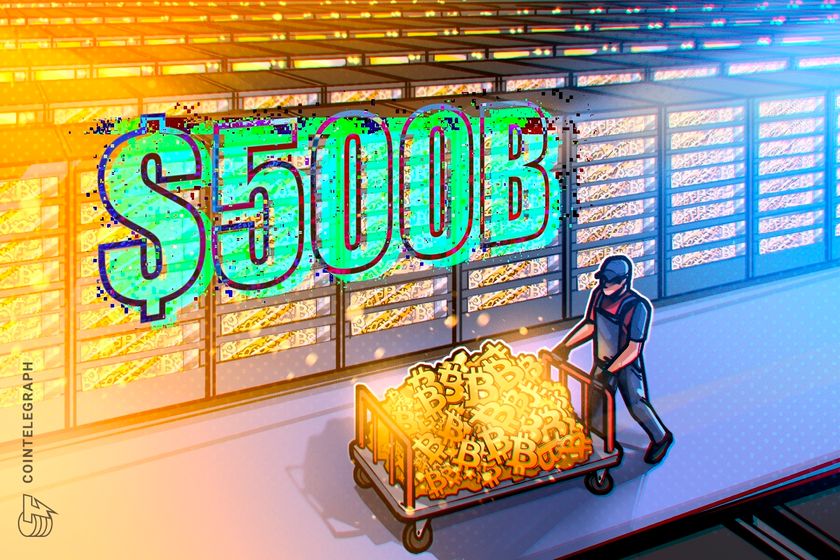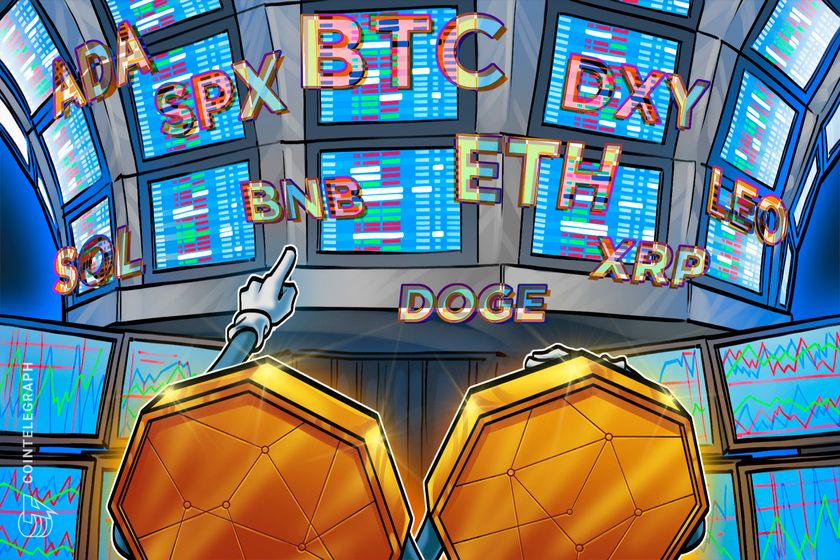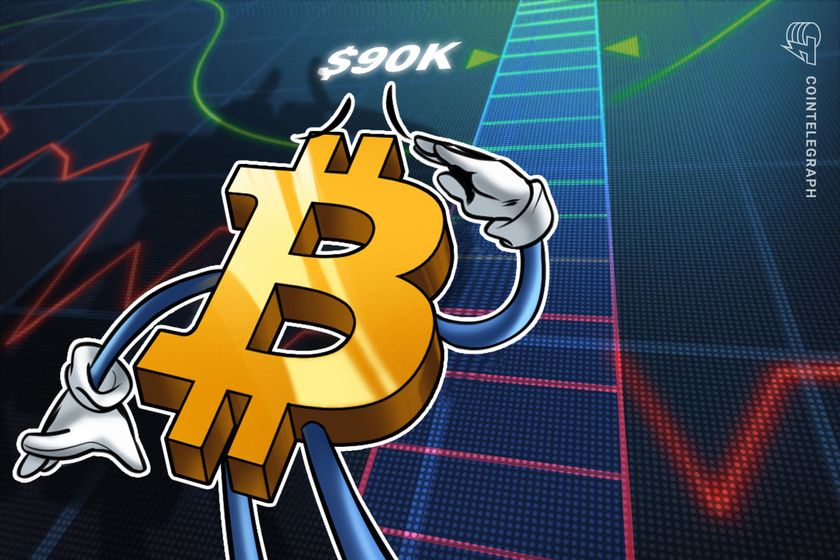Pelon ja Ahneuden Indeksi
Top 7 nousijat
| Kryptovaluutta | Muutos 24 tunnin aikana |
|---|---|
 Fartcoin (fartcoin) Fartcoin (fartcoin) | 17.03% |
| 7.6% | |
 Render (render) Render (render) | 6.17% |
 Algorand (algo) Algorand (algo) | 5.7% |
 Monero (xmr) Monero (xmr) | 5.56% |
 Hyperliquid (hype) Hyperliquid (hype) | 4.74% |
 Avalanche (avax) Avalanche (avax) | 3.87% |
Top 7 laskijat
| Kryptovaluutta | Muutos 24 tunnin aikana |
|---|---|
| -6.54% | |
| -5.64% | |
 Bitcoin Cash (bch) Bitcoin Cash (bch) | -5.06% |
 Ethena (ena) Ethena (ena) | -4.86% |
 Official Trump (trump) Official Trump (trump) | -3.92% |
 DeXe (dexe) DeXe (dexe) | -2.22% |
 Stacks (stx) Stacks (stx) | -1.94% |


Bitcoin (BTC) reclaimed the $84,500 level on April 14, and the recovery appears partially fueled by the announcement of partial import tariff relief by US President Donald Trump. However, traders’ optimism faded on April 13 when it became apparent that the relaxation was temporary and that tariffs on the electronics supply chain could be revisited.
Uncertainty surrounding the ongoing trade tensions between the US and China impacted Bitcoin markets, causing traders to lose some of their regained confidence. This explains why Bitcoin’s price failed to break above $86,000 and why BTC derivatives showed limited short-term potential, potentially setting the tone for the next few days.
Bitcoin 2-month futures annualized premium. Source: Laevitas.ch
The premium on Bitcoin monthly futures contracts peaked at 6.5% on April 11 but has since dropped to 5%, which is near a neutral to bearish threshold. Sellers typically require a 5% to 10% annualized premium for longer settlement periods, so anything below this range indicates reduced interest from leveraged buyers.
Bitcoin sentiment dims as stock market ties dent bullish momentum
Traders’ brief excitement can be linked to President Trump’s April 13 announcement that tariffs on imported semiconductors would be reviewed during the week. This suggests that exemptions for smartphones and computers are not final, according to Yahoo Finance. Trump reportedly said: “We want to make our chips and semiconductors and other things in our country.”
Bitcoin traders experienced emotional swings during this period of fluctuating expectations. The performance of broader markets, particularly large technology companies reliant on global trade, appears to have influenced Bitcoin sentiment. The strong intraday correlation between Bitcoin and stock markets has dampened bullish enthusiasm, leaving open questions about whether this effect is limited to BTC futures.
S&P 500 futures (left) vs. Bitcoin/USD (right). Source: TradingView / Cointelegraph
To determine whether Bitcoin traders’ sentiment is merely mirroring trends in the S&P 500, it is helpful to examine the BTC options markets. If professional traders anticipate a significant price drop, the 25% delta skew indicator will rise above 6%, as put (sell) options become more expensive than call (buy) options.
Bitcoin 30-day options 25% delta skew (put-call) at Deribit. Source: Laevitas.ch
On April 13, the Bitcoin options delta skew briefly dipped below 0%, signaling mild optimism. However, this momentum did not hold on April 14, reinforcing data from Bitcoin futures that show no significant bullish sentiment despite prices recovering from the $74,440 lows.
Weak spot Bitcoin ETF inflows also behind traders’ limited optimism
Another way to gauge market sentiment is by analyzing stablecoin demand in China. Strong retail interest in cryptocurrencies usually pushes stablecoins to trade at a premium of 2% or more above the official US dollar rate. In contrast, a premium below 0.5% often indicates fear as traders move away from crypto markets.
Related: Crypto markets ‘relatively orderly’ despite Trump tariff chaos: NYDIG
USDT Tether (USDT/CNY) vs. US dollar/CNY. Source: OKX
Between April 6 and April 11, Tether (USDT) in China traded at a 1.2% premium, reflecting moderate enthusiasm. However, this trend reversed, with the premium now at just 0.5%, suggesting that the earlier excitement has dissipated. Hence, traders remain cautious and show little confidence in Bitcoin surpassing $90,000 in the near term.
The announcement of Strategy’s $286 million Bitcoin acquisition at $82,618 failed to boost sentiment, as investors suspect that the recent temporary decoupling from stock market trends was largely driven by this purchase. Similarly, Bitcoin spot exchange-traded funds (ETFs) saw $277 million in outflows between April 9 and April 11, further weakening any potential improvement in trader confidence.
This article is for general information purposes and is not intended to be and should not be taken as legal or investment advice. The views, thoughts, and opinions expressed here are the author’s alone and do not necessarily reflect or represent the views and opinions of Cointelegraph.


Spot Solana exchange-traded funds (ETFs) are set to launch in Canada on April 16, according to Bloomberg analyst Eric Balchunas.
In an X post on April 14, the analyst shared a private client note from TD Bank, a Canadian financial institution, claiming the Ontario Securities Commission (OSC) greenlighted asset managers Purpose, Evolve, CI and 3iQ to issue ETFs holding Solana (SOL).
The OSC did not immediately respond to Cointelegraph’s request for comment.
Canada does not have a federal securities agency, with its territories and provinces applying their own securities laws. Toronto’s securities exchange is regulated by Ontario’s OSC.
The ETFs are permitted to stake a portion of the SOL holdings for added yield, Balchunas said, adding that the upcoming listings are “our first look at the alt coin race.”
Source: Eric Balchunas
Related: SEC approves options on spot Ether ETFs
Waiting on US approval
The US Securities and Exchange Commission (SEC) has acknowledged dozens of applications to list ETFs holding alternative cryptocurrencies, or “altcoins,” but so far has only approved funds holding spot Bitcoin (BTC) and Ether (ETH) for trading.
Staking is still off limits for US crypto ETFs. Bloomberg analyst James Seyffart said Ether ETFs could be greenlighted to start staking as soon as May, but the process may take months longer.
However, investors’ demand for altcoin ETFs may be weaker than for funds holding core cryptocurrencies, Katalin Tischhauser, crypto bank Sygnum’s research head, told Cointelegraph in August.
“[T]here is all this frothy excitement in the market about these ETFs coming, and no one can point to where substantial demand is going to come from,” Tischhauser told Cointelegraph.
Volatility Shares’ SOL futures ETF has roughly $5 million in net assets. Source: Volatility Shares
In March, asset manager Volatility Shares launched the first ETFs to track Solana’s performance using financial derivatives.
Volatility Shares Solana ETF (SOLZ) has seen a lukewarm reception, attracting only around $5 million in net assets as of April 14, according to its website.
“FWIW, the 2 solana ETFs in US (which track futures so not a perfect guinea pig) haven't done much. Very little in aum. The 2x XRP already has more aum than both the solana ETFs and it came out after,” Balchunas said.
Balchunas added that he “[w]ouldn't read a ton into it” as a predictor for spot SOL ETFs.
Magazine: Bitcoin eyes $100K by June, Shaq to settle NFT lawsuit, and more: Hodler’s Digest, April 6–12
Yhdysvaltain kotimaan laitoksen turvallisuusministeriö


The US Treasury has injected $500 billion into financial markets since February by drawing liquidity from its Treasury General Account (TGA), funding government operations after a $36 trillion debt ceiling was hit on Jan. 2, 2025.
Macroeconomic financial analyst Tomas said that this liquidity surge boosted the net Federal Reserve liquidity to $6.3 trillion, and it may support Bitcoin’s (BTC) price in the future, even though risk assets have reflected minimal growth so far.
US Treasury General Account’s expected liquidity flow. Source: X.com
The TGA represents the government’s checking account at the Federal Reserve, holding capital for daily operations like paying bills or collecting taxes. A decrease in TGA capital means the balance has been deployed into the broader economy, boosting available cash in the markets.
Tomas explained that The TGA drawdown commenced on Feb. 12, following the exhaustion of "extraordinary measures" after the debt ceiling was reached. The TGA balance has dropped from $842 to roughly $342 billion, releasing liquidity into the system, and the targeted liquidity is expected to rise up to $600 billion by the end of April.
The analyst added that the current tax season will temporarily drain liquidity, but the drawdown is expected to resume in May. If debt ceiling talks extend to August, net liquidity could hit a multi-year high of $6.6 trillion, which could cause a bullish tailwind for Bitcoin.
Bitcoin’s correlation with global liquidity. Source: Lynalden.com
According to a study by financial analyst Lyn Alden, Bitcoin has historically moved 83% of the time in line with global liquidity in a given 12-month period. The research termed “Bitcoin a Global Liquidity Barometer” compared Bitcoin to other major asset classes such as SPX, gold and VT, and BTC topped the correlation index with respect to global liquidity.
Past TGA drawdowns in 2022 and 2023 have fueled speculative assets like Bitcoin. Thus, a $600 billion boost, plus billions more added over Q2-Q3, could lift BTC’s value if market conditions remain stable.
Related: Bitcoin traders target $90K as apparent tariff exemptions ease US Treasury yields
Bitcoin eyes $137,000 by Q2-Q3, says analyst
Anonymous crypto trader Titan of Crypto shared a bullish outlook for Bitcoin, predicting that BTC could surge to a new all-time high of $137,000 by July-August 2025. In a recent X post, the analyst pointed out a bullish pennant pattern on the daily chart, with the price potentially heading toward a positive breakout.
Bitcoin bullish pennant by Titan of Crypto. Source: X.com
However, before pushing chips into a long conviction play, BTC must break and retain a position above its 200-day exponential moving average (EMA). As illustrated in the chart, Bitcoin faces resistance from all three key EMAs, namely, the 50-day, 100-day and 200-day indicators.
A collective reclaim above each moving average on a higher time frame chart could further strengthen the bullish case, allowing the crypto to retest its six-figure targets.
Bitcoin 1-day chart analysis. Source: Cointelegraph/TradingView
Related: Bybit integrates Avalon through CeFi to DeFi bridge for Bitcoin yield
This article does not contain investment advice or recommendations. Every investment and trading move involves risk, and readers should conduct their own research when making a decision.


Bitcoin (BTC) bulls are trying to start the week on a positive note by pushing the price above $85,000. Michael Saylor’s Strategy has used the recent dip to buy 3,459 Bitcoin for $285.5 million at an average price of $82,618. That boosts the total holding of the firm to 531,644 Bitcoin purchased at an average price of $67,556.
However, not everyone is bullish in the near term. Several institutional investors seem to have trimmed their holdings. CoinShares reported on April 14 that digital asset exchange-traded products (ETPs) witnessed $795 million in outflows last week. The $7.2 billion in outflows since February have reversed nearly all year-to-date inflows, now at just $165 million.
Daily cryptocurrency market performance. Source: Coin360
Although Bitcoin seems to have bottomed out in the short term, a roaring bull market rally is unlikely to start in a hurry. The tariff headlines and the outcome of the tariff talks between the United States and other countries could dictate the price action.
Could Bitcoin build upon the recovery, pulling altcoins higher? Let’s analyze the charts to find out.
S&P 500 Index price analysis
The S&P 500 Index (SPX) witnessed a hugely volatile week, but a positive sign is that lower levels attracted solid buying by the bulls.
SPX daily chart. Source: Cointelegraph/TradingView
After the massive volatility of the past few days, the index could enter a quieter phase. Sellers are likely to sell the rallies near 5,500, while the bulls are expected to buy the dips to the 5,119 support. That signals a possible range-bound action between 5,500 and 5,119 for some time.
The next trending move is expected to begin after buyers push the price above 5,500 or sink below 4,950. If the 5,500 level gets taken out, the index could surge to 5,800.
US Dollar Index price analysis
The US Dollar Index (DXY) has been in a freefall since turning down from the 20-day exponential moving average (102.81) on April 10.
DXY daily chart. Source: Cointelegraph/TradingView
Buyers defended the 99.57 level on a closing basis on April 11, but the bears renewed their selling on April 14. If the price closes below 99.57, the index could tumble to 97.50 and, after that, to 95. The longer the price remains below 99.57, the greater the risk of starting a new downtrend.
If buyers want to prevent a downward move, they will have to swiftly push the price back above 99.57. That could start a recovery to 101.
Bitcoin price analysis
Bitcoin broke above the resistance line on April 12, and the bulls successfully held the retest of the breakout level on April 13.
BTC/USDT daily chart. Source: Cointelegraph/TradingView
The 20-day EMA ($82,979) has flattened out, and the RSI is near the midpoint, suggesting that the selling pressure is reducing. The BTC/USDT pair could climb to $89,000, which is likely to act as a stiff resistance. If the price turns down sharply from $89,000 and breaks below the 20-day EMA, it will indicate a range formation. The pair may oscillate between $89,000 and $73,777 for a few days.
If sellers want to trap the aggressive bulls and retain control, they will have to quickly pull the price back below the 20-day EMA. If they do that, the pair may descend to $78,500 and subsequently to the vital support at $73,777.
Ether price analysis
Ether (ETH) is facing selling at the 20-day EMA ($1,722), as seen from the long wick on the April 14 candlestick.
ETH/USDT daily chart. Source: Cointelegraph/TradingView
If the price plummets below $1,546, the ETH/USDT pair could retest the $1,368 support. This is a crucial level for the bulls to defend because a break below $1,368 could start the next leg of the downtrend toward $1,150.
Conversely, if buyers propel the price above the 20-day EMA, it signals that the bears are losing their grip. There is resistance at the 50-day SMA ($1,955), but it is likely to be crossed. The pair may then ascend to the solid resistance at $2,111.
XRP price analysis
XRP (XRP) turned down from the 50-day SMA ($2.24) on April 13, indicating that sellers are active at higher levels.
XRP/USDT daily chart. Source: Cointelegraph/TradingView
The 20-day EMA ($2.10) has flattened out, and the RSI is near the midpoint, indicating a balance between supply and demand. A break below $2 will tilt the advantage in favor of the bears. The XRP/USDT pair could drop to $1.72 and later to $1.61.
Buyers will gain the upper hand if they push and maintain the price above the 50-day SMA. If they can pull it off, the pair could rally to the resistance line. Sellers are expected to aggressively defend the resistance line because a break above it signals a potential trend change.
BNB price analysis
BNB (BNB) is facing resistance at the downtrend line, but a minor positive is that the bulls have not ceded much ground to the bears.
BNB/USDT daily chart. Source: Cointelegraph/TradingView
That increases the likelihood of a break above the downtrend line. If that happens, the BNB/USDT pair could ascend to $645. Sellers will try to guard the $645 level, but it is likely to be crossed.
This positive view will be invalidated in the near term if the price turns down sharply from the downtrend line and breaks below $566. That could keep the pair stuck inside the triangle for a while longer.
Solana price analysis
Sellers are trying to defend the 50-day SMA ($130) in Solana (SOL), but the bulls have kept up the pressure.
SOL/USDT daily chart. Source: Cointelegraph/TradingView
If the price closes above the 50-day SMA, the SOL/USDT pair could rise to the $147 to $153 resistance zone. Sellers are expected to vigorously defend this zone, but if the bulls prevail, the pair could surge to $180.
The first support on the downside is the 20-day EMA ($123). A bounce off the 20-day EMA will keep the positive momentum intact, while a break below it could sink the pair to $110 and eventually to $95.
Related: Solana rallies 20% against Ethereum, but is $300 SOL price within reach?
Dogecoin price analysis
Buyers are trying to start a recovery in Dogecoin (DOGE) but are expected to face stiff resistance from the bears at the moving averages.
DOGE/USDT daily chart. Source: Cointelegraph/TradingView
If the price turns down from the moving averages, the bears will again attempt to sink the DOGE/USDT pair below $0.14. If they manage to do that, the selling could accelerate, and the pair may slump to $0.10.
Contrarily, if buyers propel the price above the moving averages, the pair could rally to $0.20. This is an important near-term level to watch out for because a break above it will complete a double-bottom pattern. The pair could then climb toward the pattern target of $0.26.
Cardano price analysis
Buyers are struggling to push Cardano (ADA) above the 20-day EMA ($0.65), indicating that demand dries up at higher levels.
ADA/USDT daily chart. Source: Cointelegraph/TradingView
If the price turns down from the 20-day EMA, the next support on the downside is $0.58 and then $0.50. Buyers are expected to fiercely defend the $0.50 level because a break below it could sink the ADA/USDT pair to $0.40.
On the upside, buyers will have to drive and maintain the price above the 50-day SMA ($0.71) to signal that the downtrend could be over. That could propel the pair to $0.83 and subsequently to $1.03.
UNUS SED LEO price analysis
Buyers are trying to push UNUS SED LEO (LEO) above the 20-day EMA ($9.39), but the bears are posing a substantial challenge.
LEO/USD daily chart. Source: Cointelegraph/TradingView
The flattening 20-day EMA and the RSI near the midpoint suggest a balance between supply and demand. That could keep the LEO/USD pair stuck between $9.90 and $8.79 for a few days.
The next trending move could begin on a break above $9.90 or below $8.79. If buyers kick the price above $9.90, the pair will complete a bullish ascending triangle pattern. This bullish setup has a target objective of $12.04.
On the downside, a break below $8.70 could signal the start of a deeper correction toward $8.30.
This article does not contain investment advice or recommendations. Every investment and trading move involves risk, and readers should conduct their own research when making a decision.
Yhdysvaltain arvopaperi- ja pörssikomissio (SEC ) viivästynyt päätös päätöksenteon eetterin hyväksymisestä kahdessa harmaakalassa.
GrayScale Ethereum Trust ETF: n ja GrayScale Ethereum mini Trust ETF: n päätös on lykätty 1. kesäkuuta asti, a
helmikuun 14. päivänä New Yorkin pörssi (nyse ) arkistoi ehdotetun sääntöjen muutos harmaasävyjen puolesta, joka
Staking on prosessi, jolla kryptovaluutan lukitseminen lompakkoon tukee blockchain -verkon toimintaa ja turvallisuutta, tarjoamalla Stakers -palkintoja vastineeksi. Ominaisuutta pidetään potentiaalisesti olennaisena osana eetterin ETF: ää, koska se voisi tuottaa satoa sijoittajille, mikä lisää varojen houkuttelevuutta. src u003d "https: //s3.cointelegraph.com/uploads/2025-04/01963542-7f88-7e91-9d8a-dA1730688b8a " title u003d "" >
Sec & rsquo ; Lähde: Sec


The 2-year and 10-year US Treasury yields dipped on Monday, April 14, after Bitcoin (BTC) closed its best weekly performance since the second week of January. Bitcoin gained 6.79% over the past week, but are enough factors aligned to support continued price upside?
The 10-year treasury yield declined by 8.2 basis points to 4.40% during the New York trading session, while the 2-year treasury saw an 8 basis point slip to 3.88%. The drop in yields occurred on the back of possible tariff exemptions on smartphones, computers, and semiconductors, which were introduced to give US companies time to move production domestically. However, US President Donald Trump emphasized these exemptions were temporary in nature.
US 10-year treasury bond yields chart. Source: Cointelegraph/TradingView
The tariff exemptions announced on April 12 came at the end of a bullish week for Bitcoin. After forming new yearly lows at $74,500, BTC price jumped 15% to $86,100 between April 9-13.
Easing US treasury yields could be a double-edged sword for Bitcoin. Lower yields reduce the appeal for fixed-income assets, improving capital injection into risk-on assets like BTC. Still, the uncertainty of “temporary exemptions” and the ongoing trade war with China keeps Bitcoin susceptible to further price volatility.
As an “inflation hedge,” Bitcoin continues to draw mixed opinions, but recent uncertainty over trade policies increases inflation fears, improving BTC’s store of value narrative. Yet, recent US inflation data suggested a cooling trend, as the Consumer Price Index (CPI) for March 2025 indicated a year-over-year inflation rate of 2.4%, down from 2.8% in February, marking the lowest since February 2023, which could be indirectly bearish for Bitcoin in the short term.
Related: Trade war vs record M2 money supply: 5 things to know in Bitcoin this week
Bitcoin price hurdles present at $88K to $90K
Trading resource Material Indicators noted that Bitcoin retained a bullish position above its 50-weekly moving average and quarterly open at $82,500. A strong weekly close implied a higher possibility that Bitcoin is less likely to re-visit its previous weekly lows anytime soon. The analysis added,
“Bitcoin bulls now face strong technical and liquidity-based resistance between the trend line and the 200-day MA. Expecting “Spoofy” to move asks at $88k and $92k before they get filled.”
Likewise, Alphractal founder Joao Wedson suggested that Bitcoin may be nearing a bullish reversal, as the Perpetual-Spot Gap on Binance—a key indicator tracking the price difference between Bitcoin’s perpetual futures and spot markets, has been narrowing since late 2024.
Bitcoin Perpetual-spot price gap chart. Source: X.com
In a recent X post, Wedson highlighted that this shrinking gap, currently negative, signals fading bearish sentiment, with historical trends from 2020–2021 and 2024 showing that a positive gap often leads to a Bitcoin rally. Wedson noted that a flip to a positive gap could indicate returning buyer momentum. However, he cautioned that such negative gaps persisted during the 2022–2023 bear market.
Related: Michael Saylor’s Strategy buys $285M Bitcoin amid market uncertainty
This article does not contain investment advice or recommendations. Every investment and trading move involves risk, and readers should conduct their own research when making a decision.
Suuret Transaktiot
| Kryptovaluutta | Lähettäjä | Vastaanottaja | Summa (USD) | Kun |
|---|---|---|---|---|
| Binance | Binance | $1064700 | 3 minuuttia sitten | |
| Binance | Unknown | $1758501.6 | 4 minuuttia sitten | |
| Unknown | Unknown | $2101280.2 | 4 minuuttia sitten | |
| Upbit | Unknown | $1333513.6 | 4 minuuttia sitten | |
| Unknown | Unknown | $1102590 | 4 minuuttia sitten | |
| Unknown | Binance | $1005034.8 | 4 minuuttia sitten | |
| Binance | Unknown | $2025123.5 | 5 minuuttia sitten | |
| Binance | Unknown | $101679970 | 5 minuuttia sitten |
Tämän päivän suuret taloustapahtumat
| Aika | Tapahtuma | Maa |
|---|---|---|
| 20:00:00 | Kaupan saldo | Uusi -Seelanti |
| 23:30:00 | Raakaöljyn viikoittaiset varannot American Institute of Oil (API ) mukaan | Yhdysvallat |
| 20:00:00 | Kaupan saldo | Uusi -Seelanti |
| 19:00:00 | EKP: n Lagarde puheenjohtaja puhuu | Euroalue |
| 15:30:00 | Myyntimäärä tuotantoalalla | Kanada |
| 15:30:00 | Kuluttajahinnat (IPC ) | Kanada |
| 15:30:00 | Kuluttajahinta (IPC ) | Kanada |
| 15:30:00 | NY Empire State Production Activity Index | Yhdysvallat |
| 15:30:00 | Tuontihintaindeksi | Yhdysvallat |
| 15:30:00 | Vientihinnat -indeksi | Yhdysvallat |
| 15:15:00 | Uusien talojen rakentamisen määrä | Kanada |
| 15:00:00 | GlobalDaitraden indeksiarvo | Uusi -Seelanti |
| 14:00:00 | IGP-10-inflaatioindeksi | Brasilia |
| 13:30:00 | Kuluttajahinnat (IPC ) | Intia |
| 12:00:00 | Zew: n taloudellinen mielialan indeksi | Euroalue |
| 12:00:00 | Teollisuustuotannon määrä | Euroalue |
| 12:00:00 | Zew Economic Mood Index Saksassa | Saksa |
| 12:00:00 | Nykyisten taloudellisten olosuhteiden ZW -indeksi Saksassa | Saksa |
| 11:00:00 | IMA: n kuukausittainen raportti | Yhdysvallat |
| 11:00:00 | Budjetin tasapaino | Turkki |
| 11:00:00 | Kuluttajahinnat (IPC ) | Puola |
| 09:45:00 | Yhdenmukaistettu Ranskan kuluttajahintaindeksi | Ranska |
| 09:45:00 | Kuluttajahinnat (IPC ) Ranska | Ranska |
| 09:30:00 | Tukkumyyntihintaindeksi | Intia |
| 09:00:00 | Työttömyyden taso | Iso -Britannia |
| 09:00:00 | Työllisyysmuutos, 3M/3M | Iso -Britannia |
| 09:00:00 | Työttömyysetujen hakemusten määrän muuttaminen | Iso -Britannia |
| 09:00:00 | Keskimääräinen palkkataso otetaan huomioon vakuutusmaksut | Iso -Britannia |
| 04:30:00 | Luotto- ja rahakäytäntöjen kokouksen pöytäkirja | Australia |